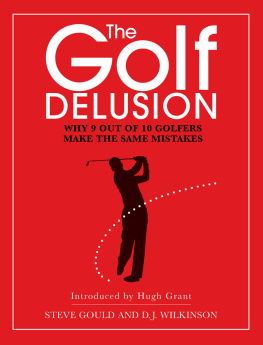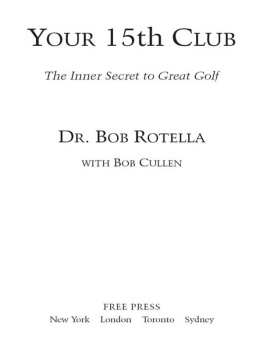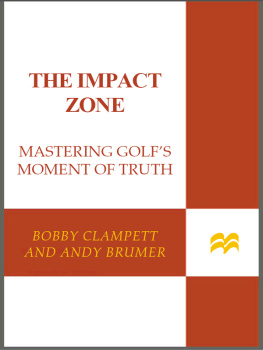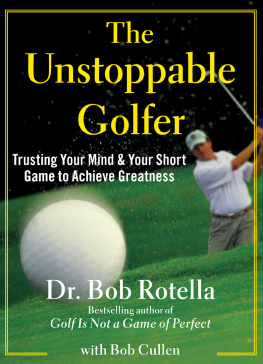

contents
This book is dedicated to my father, Fred Valiante, for always teaching me that golf, at its core, is a human game.
And to my mother, Joanne Valiante, for the endless and unconditional love and encouragement.
And finally, to Professor Frank Pajares. Thank you for the wheat fields.
www.boox.to
acknowledgments
I t has been a genuine privilege to work with Jason Kaufman, Bob Carney, Mike Stachura, Jenny Choi, and all the folks at Golf Digest and Doubleday. They are models of dedication and professional excellence.
Id like to give thanks to a number of people who helped make this book possible. To the golfers who were so generous with their time during the early days of this study: Buddy Alexander, Joan Alexander, Jonathan Byrd, Chad Campbell, Stewart Cink, Chris DiMarco, David Duval, Luke Donald, Ernie Els, Steve Flesch, Matt Kuchar, Justin Leonard, Davis Love III, Josh McCumber, Bryce Molder, Gary Nicklaus, Jack Nicklaus, Mark Omeara, Gary Player, Nick Price, Heath Slocum, Curtis Strange, and Scott Verplank. You didnt need to help, and you did anyway. That speaks volumes.
Tom Fazio believed in me and my ideas, and gave me the break I needed in order to do this study. He is an exemplary professional, philanthropist, human being, and father.
Wendy Brandon, Roger Casey, Linda Deture, Scott Hewit, Madeline Kovarik, Al Moe, Deb Wellman, and all my colleagues at Rollins College encourage and model excellence every single day. Hogan advised that we should all dine with good putters. Thats what I do with you!
Personal experience is as great a teacher as research. Ive learned many lessons on being a fearless winner from Fran Hoxie, John Bartell, Brian Cleary, Mike Bison, Jen Crane, Beth Cranston and her father General Steward Cranston, Professor Jack McDowell, Dino Doyle, Brian Froehling, Mike Grieder, Scott Hayward, Jocelyn Hoffman, Chris Aden, Dave and Mary Houle, Brian Kaineg, Steve Losardo, John and Beth Lynn, Bob Mezzo, Jeremy Moore, Adam Sehnert, John Mudry, Cory Nichols, Matt Orrell, Shane and Katie Perkey, Rick Plasky, Joe Sora, Tyrus Underwood, and Walt Rivenbark.
Some relationships transcend words. The friends who shape me and fashion my mind, and who model ethics, character, and excellence every day, are Christian Hoffman, Eric Mudry, and John Black. Gentlemen, thank you!
Golf is a human game. We all play together.

T hink of the great moments in golf.
Think of Ben Hogan at Merion in 1950, just sixteen months from a horrific car crash that nearly took his life and left his legs too weak to resume a full tournament schedule. On the final 36-hole day of the U.S. Open that year, Hogan faced a stunningly difficult 1-iron shot from the fairway uphill to the green on the long par 4 finishing hole. The great champion, whose weary legs barely held him up through the final 18 holes, made as majestically precise a swing as the game has ever seen at that crucial moment, and his textbook par propelled him into a playoff he would win the next day. At the moment of truth, Hogan was determined, resolute, and unfazed. He was, in a word, fearless. The view I take of this shot is markedly different from the view most spectators seem to have formed, Hogan later wrote in his definitive instruction book, The Modern Fundamentals of Golf:
They are inclined to glamorize the actual shot since it was hit in a pressureful situation. They tend to think of it as something unique in itself, something almost inspired, you might say, since the shot was just what the occasion called for. I dont see it that way at all. I didnt hit that shot thenthat late afternoon at Merion. Id been practicing that shot since I was 12 years old. After all, the point of tournament golf is to get command of a swing which, the more pressure you put on it, the better it works.
Think of Jack Nicklaus, seemingly well past his prime at age forty-six, striding the fairways of Augusta National on the final day of the 1986 Masters with a renewed vigor and focus and passion. With others around him doubting his chances, Nicklaus was driven by a consuming belief in his potential, and he would not be denied. He rallied from 5 strokes off the lead to win his sixth green jacket, fearlessly charging to the lead with a back nine 30 while other, younger players faded in the final-round pressure. In the heat of that great moment, Nicklaus was relentless, sure, and focused. He, too, was fearless. This was Sunday at the Masters, Nicklaus said that victorious evening. Theres a lot of pressure. The other guys feel it, too. They can make mistakes. I knew if I kept my composure down the stretch, as long as I kept making birdies, Id be OK. I kept that right at the front of my mind.... I told my son Jackie, my caddie, at the seventeenth that this was the most fun Ive had in five or six years.
Think of Tiger Woods in 2000, when the games next great player seemed at his invincible best. Yet at the PGA Championship at Valhalla that August he was matched stride for stride by Bob May, an unheralded, unruffled veteran who had never won a PGA Tour event. On the verge of the greatest year in the history of professional golf, Woods had everything to lose, yet he refused to wilt on the biggest stage in the biggest moment. Staring at an unsettling, sliding putt on the eighteenth green, knowing May had just made another birdie and knowing a miss would mean defeat, Woods faced elimination stout and strong and undaunted. He, like Hogan and like Nicklaus, also was fearless. You have to reach deep inside yourself and you have to keep making birdies, he said. We never backed off from one another. Birdie for birdie and shot for shot, we were going right at each other. That was just so much fun. Thats as good as it gets right there.
When I turn my critical eye on all these great moments, there is one thing the great champions manage to overcome. It is a greater foe than any apparently invincible opponent, than any brutally penal golf course itself or even the unshakable enormity of any once-in-a-lifetime moment. It is fear, the most critical impediment to playing golf to your greatest potential. It matters not if you are a weekend hacker in the later stages of your usual Saturday game or a PGA Tour champion stepping to the eighteenth tee with a one-shot lead. If there is one universal truth to golfers of all levels, it is fear, fear of failure, fear of embarrassment, fear of the unexpected, fear of poor judgment. It is fear of long courses, of short courses, of narrow courses, of hilly courses and flat courses. It is fear of water hazards and sand bunkers, of short putts and long putts. We even fear things that in reality arent there, like that flagstick that looks to be inches beyond a bunker when its really a dozen or more yards.
It is fear of playing with certain people or against certain people or even in front of certain people. It is even fear of knowing we are afraid, and it gnaws on our consciousness, undermines our skills, sabotages our capabilities, and infects our confidence.
So let me be clear and succinct on the foundation of this book: A golfers greatest enemy is fear, but playing our greatest golf begins by making fearless swings at specific targets, regardless of the circumstances. In the simplest terms,














